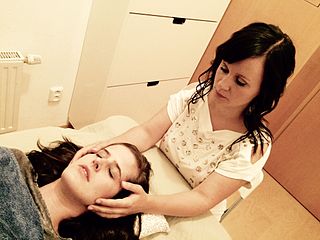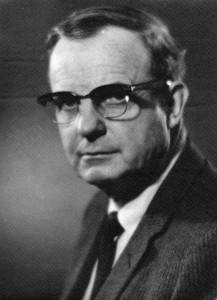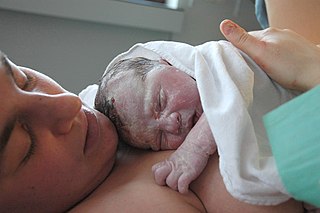Related Research Articles

Acupressure is an alternative medicine technique often used in conjunction with acupuncture or reflexology. It is based on the concept of life energy (qi), which purportedly flows through "meridians" in the body. In treatment, physical pressure is applied to acupuncture points, or ashi trigger points, with the aim of clearing blockages in these meridians. Pressure may be applied by hand, by elbow, or with various devices. There is no scientific evidence for the existence of acupuncture points, meridians, or qi.

Massage is the rubbing or kneading of the body's soft tissues. Massage techniques are commonly applied with hands, fingers, elbows, knees, forearms, feet or a device. The purpose of massage is generally for the treatment of body stress or pain. In European countries, a person professionally trained to give massages is traditionally known as a masseur (male) or masseuse (female). In the United States, these individuals are often referred to as "massage therapists". In some provinces of Canada, they are called "registered massage therapists."
Magnetic therapy is a pseudoscientific alternative medicine practice involving the weak static magnetic field produced by a permanent magnet which is placed on the body. It is similar to the alternative medicine practice of electromagnetic therapy, which uses a magnetic field generated by an electrically powered device. Magnet therapy products may include wristbands, jewelry, blankets, and wraps that have magnets incorporated into them.

Physical intimacy is sensuous proximity or touching. It is an act or reaction, such as an expression of feelings, between people. Examples of physical intimacy include being inside someone's personal space, holding hands, hugging, kissing, caressing and sexual activity. Physical intimacy can often convey the real meaning or intention of an interaction in a way that accompanying speech cannot do. Physical intimacy can be exchanged between any people but as it is often used to communicate positive and intimate feelings, it most often occurs in people who have a preexisting relationship, whether familial, platonic or romantic, with romantic relationships having increased physical intimacy. Several forms of romantic touch have been noted including holding hands, hugging, kissing, cuddling, as well as caressing and massaging. Physical affection is highly correlated with overall relationship and partner satisfaction.

Reflexology, also known as zone therapy, is an alternative medical practice involving the application of pressure to specific points on the feet, ears, and hands. This is done using thumb, finger, and hand massage techniques without the use of oil or lotion. It is based on a system of zones and reflex areas that purportedly reflect an image of the body on the feet and hands, with the premise that such work on the feet and hands causes a physical change to the supposedly related areas of the body.

Craniosacral therapy (CST) or cranial osteopathy is a form of alternative medicine that uses gentle touch to feel non-existent rhythmic movements of the skull's bones and supposedly adjust the immovable joints of the skull to achieve a therapeutic result. CST is a pseudoscience and its practice has been characterized as quackery. It is based on fundamental misconceptions about the anatomy and physiology of the human skull and is promoted as a cure-all for a variety of health conditions.

Harry Frederick Harlow was an American psychologist best known for his maternal-separation, dependency needs, and social isolation experiments on rhesus monkeys, which manifested the importance of caregiving and companionship to social and cognitive development. He conducted most of his research at the University of Wisconsin–Madison, where humanistic psychologist Abraham Maslow worked with him for a short period of time.

Kangaroo mother care (KMC), which involves skin-to-skin contact (SSC), is an intervention to care for premature or low birth weight (LBW) infants. The technique and intervention is the recommended evidence-based care for LBW infants by the World Health Organization (WHO) since 2003.
A relaxation technique is any method, process, procedure, or activity that helps a person to relax; attain a state of increased calmness; or otherwise reduce levels of pain, anxiety, stress or anger. Relaxation techniques are often employed as one element of a wider stress management program and can decrease muscle tension, lower blood pressure, and slow heart and breath rates, among other health benefits.
Myofascial release is an alternative medicine therapy claimed to be useful for treating skeletal muscle immobility and pain by relaxing contracted muscles, improving blood and lymphatic circulation and stimulating the stretch reflex in muscles.

Alternative cancer treatment describes any cancer treatment or practice that is not part of the conventional standard of cancer care. These include special diets and exercises, chemicals, herbs, devices, and manual procedures. Most alternative cancer treatments do not have high-quality evidence supporting their use and many have been described as fundamentally pseudoscientific. Concerns have been raised about the safety of some purported treatments and some have been found unsafe in clinical trials. Despite this, many untested and disproven treatments are used around the world.
Haptic perception means literally the ability "to grasp something". Perception in this case is achieved through the active exploration of surfaces and objects by a moving subject, as opposed to passive contact by a static subject during tactile perception.

Touch is perceiving the environment using skin. Specialized receptors in the skin send signals to the brain indicating light and soft pressure, hot and cold, body position and pain. It is a subset of the sensory nervous system, which also includes the visual, auditory, olfactory, gustatory and vestibular senses.

Infant massage is a type of complementary and alternative treatment that uses massage therapy for babies. Evidence is insufficient to support its use in either full term or preterm babies to achieve physical growth.
Pain in babies, and whether babies feel pain, has been a large subject of debate within the medical profession for centuries. Prior to the late nineteenth century it was generally considered that babies hurt more easily than adults. It was only in the last quarter of the 20th century that scientific techniques finally established babies definitely do experience pain – probably more than adults – and developed reliable means of assessing and of treating it. As recently as 1999, it was widely believed by medical professionals that babies could not feel pain until they were a year old, but today it is believed newborns and likely even fetuses beyond a certain age can experience pain.
Carlo V. Bellieni is an Italian neonatologist and a bioethicist. He served as Secretary of the Bioethics Committee of the Italian Pediatrics Society. He is a member of the ethical board of the Siena Biotech research facility and the Ethical Board of the Siena University Hospital where he directs the neonatal intensive therapy unit. He follows the empirical approach in bioethics, which emphasizes realism, reason, and empathy. Bellieni authored numerous clinical research papers in international scientific journals, and several books on neonatal pain and bioethics.
Pediatric massage is the complementary and alternative treatment that uses massage therapy, or "the manual manipulation of soft tissue intended to promote health and well-being" for children and adolescents. Its goal is to reduce pain, anxiety, loneliness and fear when children are hospitalized or diagnosed with a debilitating medical condition. Pediatric massage therapy takes into consideration each child's individual physical development, cognitive development and health care needs.
Psychosensory therapy is a form of therapeutic treatment that uses sensory stimuli to affect psychological and emotional health. In addition, psychosensory therapy is a group of therapeutic techniques that involves applying sensory inputs to treat various behaviors, mood, thoughts, symptoms, and pain. Psychosensory therapy has its roots in traditional Chinese medicine in addition to energy psychology. Some important figures in psychosensory therapy include chiropractor George Goodheart, psychiatrist John Diamond, clinical psychologist Roger Callahan, and Ronald Ruden.

Caroline Anne Crowther is an Australian/New Zealand medical researcher specialising in maternity and child health. She is associated with both the University of Auckland and the University of Adelaide, being a professor at each institution. Crowther has been the recipient of multiple medical research grants.
Consoling touch is a pro-social behavior involving physical contact between a distressed individual and a caregiver. The physical contact, most commonly recognized in the form of a hand hold or embrace, is intended to comfort one or more of the participating individuals. Consoling touch is intended to provide consolation - to alleviate or lessen emotional or physical pain. This type of social support has been observed across species and cultures. Studies have found little difference in the applications of consoling touch, with minor differences in frequency occurrence across cultures. These findings suggest a degree of universality. It remains unclear whether the relationship between social touch and interpersonal emotional bonds reflect biologically driven or culturally normative behavior. Evidence of consoling touch in non-human primates, who embrace one another following distressing events, suggest a biological basis. Numerous studies of consoling touch in humans and animals unveil a consistent physiological response. An embrace from a friend, relative, or even stranger can trigger the release of oxytocin, dopamine, and serotonin into the bloodstream. These neurotransmitters are associated with positive mood, numerous health benefits, and longevity. Cortisol, a stress hormone, also decreases. Studies have found that the degree of intimacy and quality of relationship between consoler and the consoled mediates physiological effects. In other words, while subjects experience reduced cortisol levels while holding the hand of a stranger, they exhibit a larger effect when receiving comfort from a trusted friend, and greater still, when holding the hand of a high quality romantic partner.
References
- ↑ Goleman, Daniel (1988-08-18). "HEALTH: CHILD DEVELOPMENT; For Some Babies Troubled at Birth, Signs of Hope". The New York Times. ISSN 0362-4331 . Retrieved 2017-12-09.
- ↑ Goleman, Daniel (1988-02-02). "The Experience of Touch: Research Points to a Critical Role". The New York Times. ISSN 0362-4331 . Retrieved 2017-12-09.
- 1 2 "Tiffany Field Leads Guinness World Record". Fielding Graduate University. 31 July 2017. Retrieved 2017-12-09.
- ↑ "Boyd McCandless Award". APA. Retrieved 2017-12-09.
- ↑ "2014: Rat and Infant Massage". The Golden Goose Award. Retrieved 2017-12-09.
- ↑ "Psychologist wins Golden Goose Award". APA. Retrieved 2017-12-09.
- ↑ Field, Tiffany M. (2007). The amazing infant (1st ed.). Oxford, UK: Blackwell Pub. ISBN 978-1405153928. OCLC 71285164.
- ↑ Field, Tiffany M. (1990). Infancy . Cambridge, Mass.: Harvard University Press. ISBN 0674452631. OCLC 21560635.
- ↑ Field, Tiffany M. (2001). Touch . Cambridge, Mass.: MIT Press. ISBN 0262561565. OCLC 52290590.
- ↑ Field, Tiffany M. (2000). Touch therapy . Edinburgh: Churchill Livingstone. ISBN 0443057915. OCLC 41527868.
- ↑ Field, Tiffany M. (2009). Complementary and alternative therapies research . American Psychological Association. (1st ed.). Washington, DC: American Psychological Association. ISBN 9781433813993. OCLC 656836995.
- ↑ Field, Tiffany M. (2006). Massage therapy research (1st ed.). Edinburgh: Elsevier Churchill Livingstone. ISBN 0443102015. OCLC 460904356.
- ↑ Field, Tiffany M.; et al. (1986). "Tactile/Kinesthetic Stimulation Effects on Preterm Neonates". Pediatrics. 77 (5): 654–658. doi:10.1542/peds.77.5.654. PMID 3754633.
- ↑ Goleman, Daniel (1988-02-02). "The Experience of Touch: Research Points to a Critical Role". The New York Times. ISSN 0362-4331 . Retrieved 2017-10-16.
- ↑ Field, T.; Hemandez-Reif, M.; Hart, S.; Theakston, H.; Schanberg, S.; Kuhn, C. (1999-01-01). "Pregnant women benefit from massage therapy". Journal of Psychosomatic Obstetrics & Gynecology. 20 (1): 31–38. doi:10.3109/01674829909075574. ISSN 0167-482X. PMID 10212885.
- ↑ "What to Expect from Pregnancy Massage - MASSAGE Magazine". www.massagemag.com. 31 July 2015. Retrieved 2017-11-11.
- ↑ Field, Tiffany; Hernandez-Reif, Maria; Seligmen, Susan; Krasnegor, Josh; Sunshine, William; Rivas-Chacon, Rafael; Schanberg, Saul; Kuhn, Cynthia (1997-10-01). "Juvenile Rheumatoid Arthritis: Benefits from Massage Therapy". Journal of Pediatric Psychology. 22 (5): 607–617. doi: 10.1093/jpepsy/22.5.607 . ISSN 0146-8693. PMID 9383925.
- ↑ Field, Tiffany; Diego, Miguel; Hernandez-Reif, Maria; Shea, Jean (2007). "Hand arthritis pain is reduced by massage therapy". Journal of Bodywork and Movement Therapies. 11 (1): 21–24. doi:10.1016/j.jbmt.2006.09.002.
- ↑ Hartshorn, Kristen; Delage, Jesse; Field, Tiffany; Olds, Loren (2002). "Senior citizens benefit from movement therapy". Journal of Bodywork and Movement Therapies. 6 (1): 55–58. doi:10.1054/jbmt.2001.0229.
- ↑ Field, Tiffany (2016). "Knee osteoarthritis pain in the elderly can be reduced by massage therapy, yoga and tai chi: A review". Complementary Therapies in Clinical Practice. 22: 87–92. doi:10.1016/j.ctcp.2016.01.001. PMID 26850812.
- ↑ Konnikova, Maria (2015-03-04). "The Power of Touch". The New Yorker. ISSN 0028-792X . Retrieved 2017-11-11.